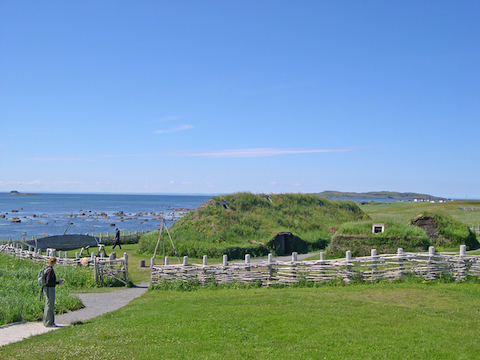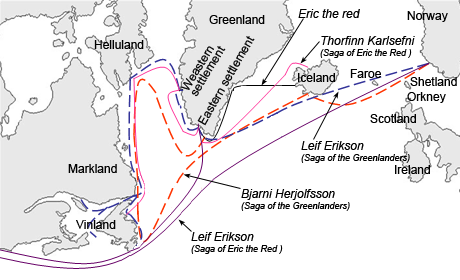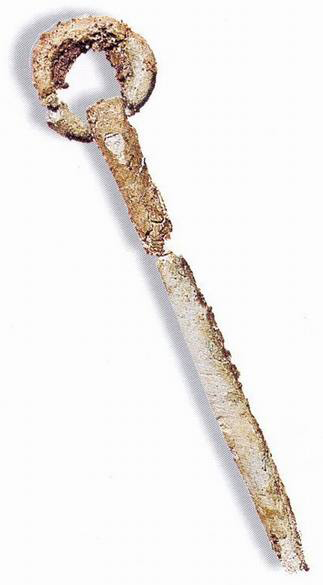
In 1492, Columbus sailed the ocean blue. But…
In 1021, the Vikings landed in Newfoundland.
That’s right, we’re now certain that Norse explorers reached North America nearly 500 years before the Spaniards.
It happened at L’Anse aux Meadows, in easternmost Canada, where explorers in the 1960s discovered the remains of Viking longhouses. But they didn’t know exactly when they arrived or left.
We now know they were here exactly in 1021.
That’s because a team of scientists has figured out how to tie tree rings to solar storms.
Different texts, from isolated countries around the world, describe red auroras in the sky in the year 993—a telltale sign of a solar storm, when radiation bombards our atmosphere.
The radiation produces higher levels of carbon-14, which is absorbed by plants.
The researchers studied wood scraps from trees cut at L’Anse aux Meadows, probably to build its Viking architecture. When they found correspondingly high levels of carbon-14 in a tree ring, it pegged that ring to the year 993. They could then count outward to the bark to identify the year the tree died.
All trees showed marks from iron tools, which no native tribes had at the time. And all were felled a thousand years ago, in 1021.
Background
Synopsis: Scientists have used astrophysics to determine the exact year that Viking explorers built a settlement at the northern tip of Newfoundland. They were able to pick out the radiocarbon (14C) signature of an extreme solar superstorm within tree rings then count outward to the tree bark to work out the year three trees were felled to build nearby structures. Historical texts suggest seafarers such as Leif Erikson traveled beyond Greenland around the turn of the millennium. All three trees analyzed were cut down in the year 1021—a thousand years ago and 471 years before Columbus discovered the New World.
- Vikings expanded out of Scandinavia from around AD 793 to 1066 from the British Isles to the west and into Russia to the east.
- They settled Iceland in around 874 then pushed west to Greenland and beyond.
- Icelandic Vikings published records of their explorations in the epic Vinland Sagas: Erik the Red’s Saga and The Saga of the Greenlanders.

Graphical description of the different sailing routes to Greenland, Vinland (Newfoundland), Helluland (Baffin Island) and Markland (Labrador) travelled by different characters in the Icelandic sagas, mainly Eric the Red’s Saga and The Saga of the Greenlanders. Credit: Masae, CC BY-SA 3.0 <http://creativecommons.org/licenses/by-sa/3.0/>, via Wikimedia Commons - Written down sometime between 1200–1300, the stories are embellished with mythology and intrigue generated through storytelling in the centuries after the events occurred.
- The sagas document sightings of the North American landmass when ships were blown off course during journeys from Iceland to Greenland.
- Later, explorers like Leif Erikson set out to explore these new lands and established base camps to explore inland from the coast.
- The Norse never established permanent settlements in Newfoundland, due to conflicts with the native people, a proto-Inuit people group, instead concentrating their population in Greenland settlements.
- The exact timing of these explorations has been difficult to constrain over the years, but recent studies have returned surprisingly precise results.
- Before the 1960s, there was no physical evidence of Viking outposts in the “New World.”
- In 1960, a settlement of eight structures was discovered on the northernmost tip of Newfoundland in northeastern Canada, including Norse artifacts.
- The Norwegian scientific team that documented the find at L’Anse aux Meadows (the bay of the grasslands) was the husband and wife team of Helge and Anne Ingstad.
- To their disappointment, radiocarbon (14C) dates from the artifacts spanned the entire age of Viking exploration.
- The team suggested that the settlement was occupied around AD 1000 based on the style of archaeological artifacts.

This bronze Viking cloak pin, characteristic of artifacts from around 1000 AD, was excavated from a settlement in L'Anse aux Meadows in northern Newfoundland. Credit: Canadian Military Heritage Volume 1
- Recently, collaboration between dendrochronologists and astrophysicists has resulted in an incredibly precise approach to refining dates—combining annual tree rings and historical solar superstorms.
-
- In a previous EarthDate, episode (ED-211), we talked about the impact of specific solar superstorms that occurred in 1770, 1859 and 1921.
- Historical records from Asia provide evidence of intense solar storms in AD 774–775 and AD 992–993. There have been only a few of these events in the past 10,000 years.
- When solar storms occur, more radiocarbon (14C) pummels Earth’s flora and photosynthesis incorporates it in plant cells at a higher ratio during those years.
- Dendrochronologists had typically averaged 10 years of tree rings in their analyses, but, once they decreased their samples to single year rings, they started to discover correlative single year spikes.
- The annual nature of tree rings provides a way to establish the exact year that certain events occurred.
- Experts who had studied the L’Anse aux Meadows site since the 1970s had preserved discarded wood found near the buildings, so researchers went to investigate.
- The samples were hewn with metal tools that the indigenous people groups did not have access to and were deemed to be related to construction of the Viking structures.
- The scientists needed cross sections of trees including the bark to ensure they had the whole record of the tree’s life until it was felled.
- They found three different trees perfect for the study.
- And all 3 had a ring with high 14C (AD 993) located 28 rings from the bark, making the date all three of the trees were cut 993+28=1021.
- 1021 is a year when Vikings were active at the location.
- Researchers hope to use the same technique to learn more about the timing of events at the site, including understanding more about the duration of the Viking habitation and visitation.

